Creating a List of Works Cited
Directory to Works-Cited-List Models
Author Listings
Books (Print, Electronic, Database)
Articles (Print, Online, Database)
Multimedia Sources (Live, Print, Electronic, Database)
In your MLA-style research paper, every source you cite must have a corresponding entry in the list of works cited, and every entry in your list of works cited must correspond to at least one citation in your research project.
Follow these rules when formatting your list of works cited in MLA style:
- Double-space the whole works-cited list.
- Alphabetize entries by the first word in the citation (usually the first author’s last name, or the title if the author is unknown, ignoring A, An, or The).
- Use a “hanging indent” for all entries: Do not indent the first line, but indent second and subsequent lines of the entry by half an inch (or five spaces).
- Shorten publishers’ names: Abbreviate compound or hyphenated names to the first name only (Bedford/St. Martin’s becomes Bedford, for example); omit words like Company or Books; and for university presses, shorten the words University and Press to U and P.
Nowadays, many print sources are also available in an electronic format, either online or through a database your school’s library subscribes to. For most online versions of a source, follow the form of the corresponding print version. For example, if you are citing an article from an online periodical, put the article title in quotation marks and italicize the name of the periodical. If the source has also been published in print (as with most e-books and many magazines and newspapers that appear online), include the print publication information if it is available. Also include information specific to the version of the source you used.
| For sources accessed through a database, include the following: | For other online sources, include the following: |
|
|
Content on the Web frequently changes or disappears, and because the same information that traditionally published books and periodicals provide is not always included for Web sources, giving your reader a complete citation is not always possible. Always keep your goal in mind: to provide enough information so that your reader can track down the source. If you cannot find all of the information listed here, include what you can.
Author Listings
One author List the author last name first (followed by a comma), and insert a period at the end of the name.
Isaacson, Walter.
Two or three authors List the first author last name first (followed by a comma). List the other authors in the usual first-name/last-name order. Insert the word and before the last author’s name, and follow it with a period.
Saba, Laura, and Julie Gattis.
Wilmut, Ian, Keith Campbell, and Colin Tudge.
Four or more authors List the first author last name first (followed by a comma). Then either list all the authors’ names (in the usual first-name/last-name order, with a comma between authors, the word and before the last name, and a period after it) or insert et al. (which means and others in Latin) in regular type (not italics). Whichever you decide to do, be sure to use the same format in your in-text citation.
Hunt, Lynn, Thomas R. Martin, Barbara H. Rosenwein, R. Po-chia Hsia, and Bonnie G. Smith.
Hunt, Lynn, et al.
Unknown author Begin the entry with the title.
Primary Colors: A Novel of Politics.
“Out of Sight.”
Corporation, organization, or government agency as author Use the name of the corporation, organization, or government agency as the author.
RAND Corporation.
United States. National Commission on Terrorist Attacks.
Two or more works by the same author Replace the author’s name in subsequent entries with three hyphens, and alphabetize the works by the first important word in the title:
Eugenides, Jeffrey. The Marriage Plot.
---. Middlesex.
---. “Walkabout.”
Books (Print, Electronic, Database)
Basic format (print, e-book, database)
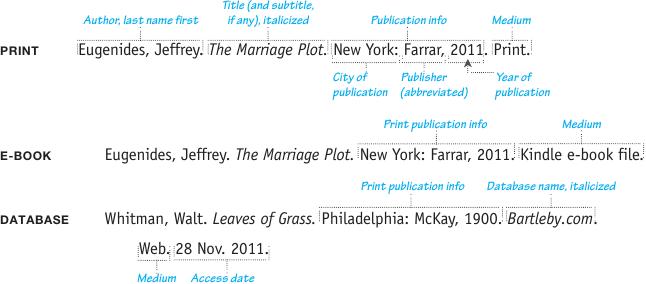
Figure 27.1 shows you where to find the source information you will need to create a works-cited entry for a book.
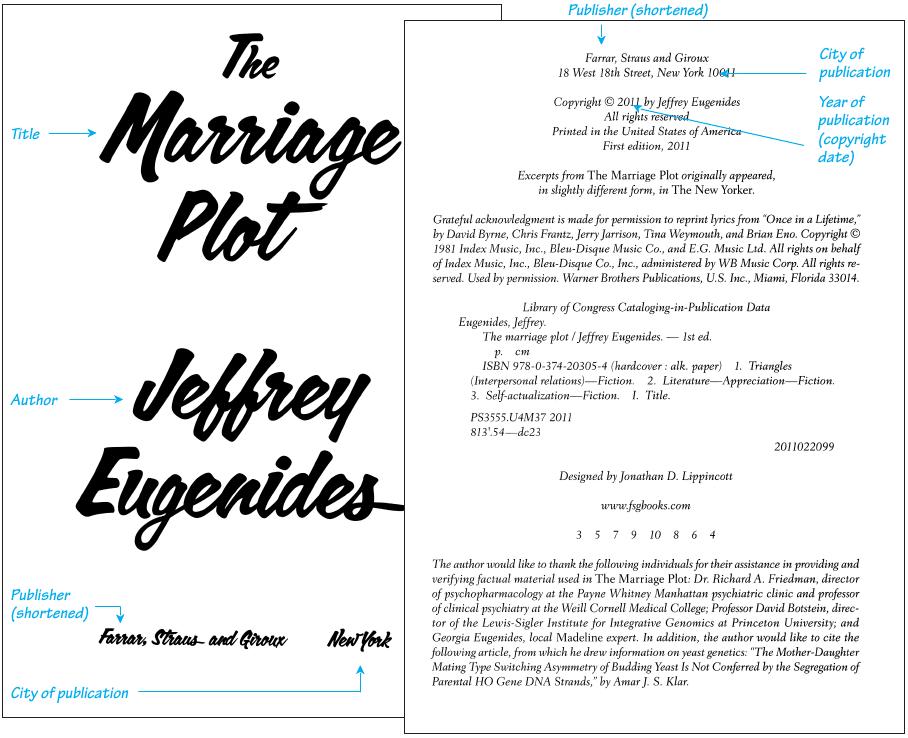
Anthology or edited collection If you are referring to the anthology as a whole, put the editor’s name first.
Masri, Heather, ed. Science Fiction: Stories and Contexts. Boston: Bedford, 2009. Print.
Work in an anthology or edited collection If you’re referring to a selection in an anthology, begin the entry with the name of the selection’s author.
Hopkinson, Nalo. “Something to Hitch Meat To.” Science Fiction: Stories and Contexts. Ed. Heather Masri. Boston: Bedford, 2009. 838-50. Print.
If you cite more than one selection from an anthology or collection, you may create an entry for the collection as a whole (see the model above) and then cross-reference individual selections to that entry.

Introduction, preface, foreword, or afterword
Murfin, Ross C. Introduction. Heart of Darkness. By Joseph Conrad. 3rd ed. Boston: Bedford, 2011. 3-16. Print.
Translation
Tolstoy, Leo. War and Peace. Trans. Richard Pevear and Larissa Volokhonsky. New York: Vintage, 2009. Print.
Graphic narrative If the graphic narrative was a collaboration between a writer and an illustrator, begin your entry with the name of the person on whose work your research project focuses. If the author also created the illustrations, then follow the basic model for a book with one author (p. 716).
Pekar, Harvey, and Joyce Brabner. Our Cancer Year. Illus. Frank Stack. New York: Four Walls Eight Window, 1994. Print.
Religious work Include an entry in the list of works cited only if you cite a specific edition of a sacred text.
The Qu’ran: English Translation and Parallel Arabic Text. Trans. M. A. S. Abdel Haleem. New York: Oxford UP, 2010. Print.
Multivolume work If you use only one volume from a multivolume work, indicate the volume number after the title. If you use more than one volume, indicate the total number of volumes after the title.

Later edition of a book Include the edition name (such as Revised) or number following the title.
Rottenberg, Annette T., and Donna Haisty Winchell. The Structure of Argument. 6th ed. Boston: Bedford, 2009. Print.
Republished book Provide the original year of publication after the title of the book, followed by publication information for the edition you are using.

Title within a title When a title that is normally italicized appears within a book title, do not italicize it. If the title within the title would normally be enclosed in quotation marks, include the quotation marks and also set the title in italics.
Hertenstein, Mike. The Double Vision of Star Trek: Half-Humans, Evil Twins, and Science Fiction. Chicago: Cornerstone, 1998. Print.
Miller, Edwin Haviland. Walt Whitman’s “Song of Myself”: A Mosaic of Interpretation. Iowa City: U of Iowa P, 1989. Print.
Book in a series Include the series title and number (if any) after the medium of publication. If the word Series is part of the name, include the abbreviation Ser. before the series number. (This information will appear on the title page or on the page facing the title page.) Abbreviate any commonly abbreviated words in the series title.
Zigova, Tanya, et al. Neural Stem Cells: Methods and Protocols. Totowa: Humana, 2002. Print. Methods in Molecular Biology 198.
Dictionary entry or article in another reference book (print, online, database) If no author is listed, begin with the entry’s title. (But check for initials following the entry or article and a list of authors in the front of the book.) If the reference work is familiar, omit the publication information.
| “Homeopathy.” Webster’s New World College Dictionary. 4th ed. 1999. Print. | |
| Trenear-Harvey, Glenmore S. “Farm Hall.” Historical Dictionary of Atomic Espionage. Lanham: Scarecrow, 2011. Print. | |
| ONLINE |

|
| DATABASE |

|
Government document (print, online) If no author is named, begin with the government and agency that issued the document. If the author is named, include that information either before or after the document’s title (introduced with the word By). In the United States, the publication information for most print government documents is Washington: GPO. (GPO stands for Government Printing Office.) But most government documents are now published online.
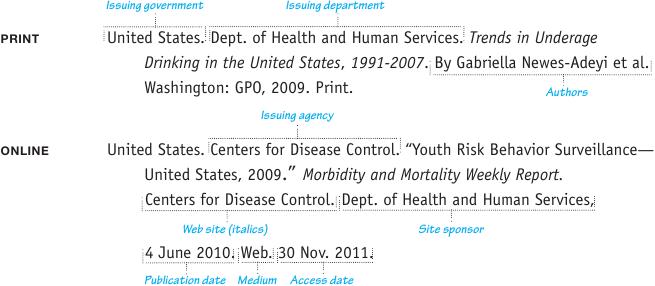
Published proceedings of a conference If the name of the conference is part of the title of the publication, it need not be repeated. If it isn’t part of the title, insert the name of the conference following the title. Use the format for a work in an anthology to cite an individual presentation (see p. 717).

Pamphlet or brochure
U.S. Foundation for Boating Safety and Clean Water. Hypothermia and Cold Water Survival. Alexandria: U.S. Foundation for Boating, 2001. Print.
Doctoral dissertation (published, unpublished) Cite a published dissertation as you would a book, but add pertinent dissertation information before the publication data. Enclose the title of an unpublished dissertation in quotation marks.

Articles (Print, Online, Database)
Articles appear in periodicals—works that are issued at regular intervals such as scholarly journals, newspapers, and magazines—Most periodicals today are available both in print and in electronic form (online or through an electronic database); some are available only in electronic format. If you are using the online version of an article, use the models provided here. If no model matches your source exactly, choose the closest print match, and add the site sponsor, the medium, and the date you last accessed the site, along with any other information your reader will need to track down the source.
From a scholarly journal (print, online, database) Scholarly journals are typically identified using their volume and issue numbers, separated by a period.
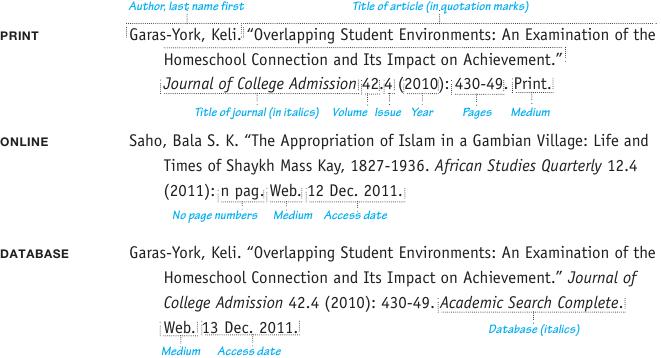
If a journal does not use volume numbers, provide the issue number only.
For help distinguishing between scholarly journals and magazines, see Chapter 25.
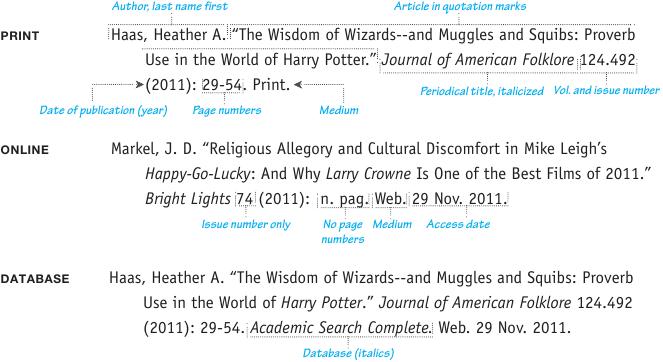
Online journals may not include page numbers; if paragraph or other section numbers are provided, use them instead. Otherwise, insert n. pag. (for no page numbers). If the article is not on a continuous sequence of pages, give the first page number followed by a plus sign. (See entry for a print version of a newspaper for an example.)
Figure 27.2 shows where to find the source information you will need to create a works-cited entry for three of the journal articles cited here.
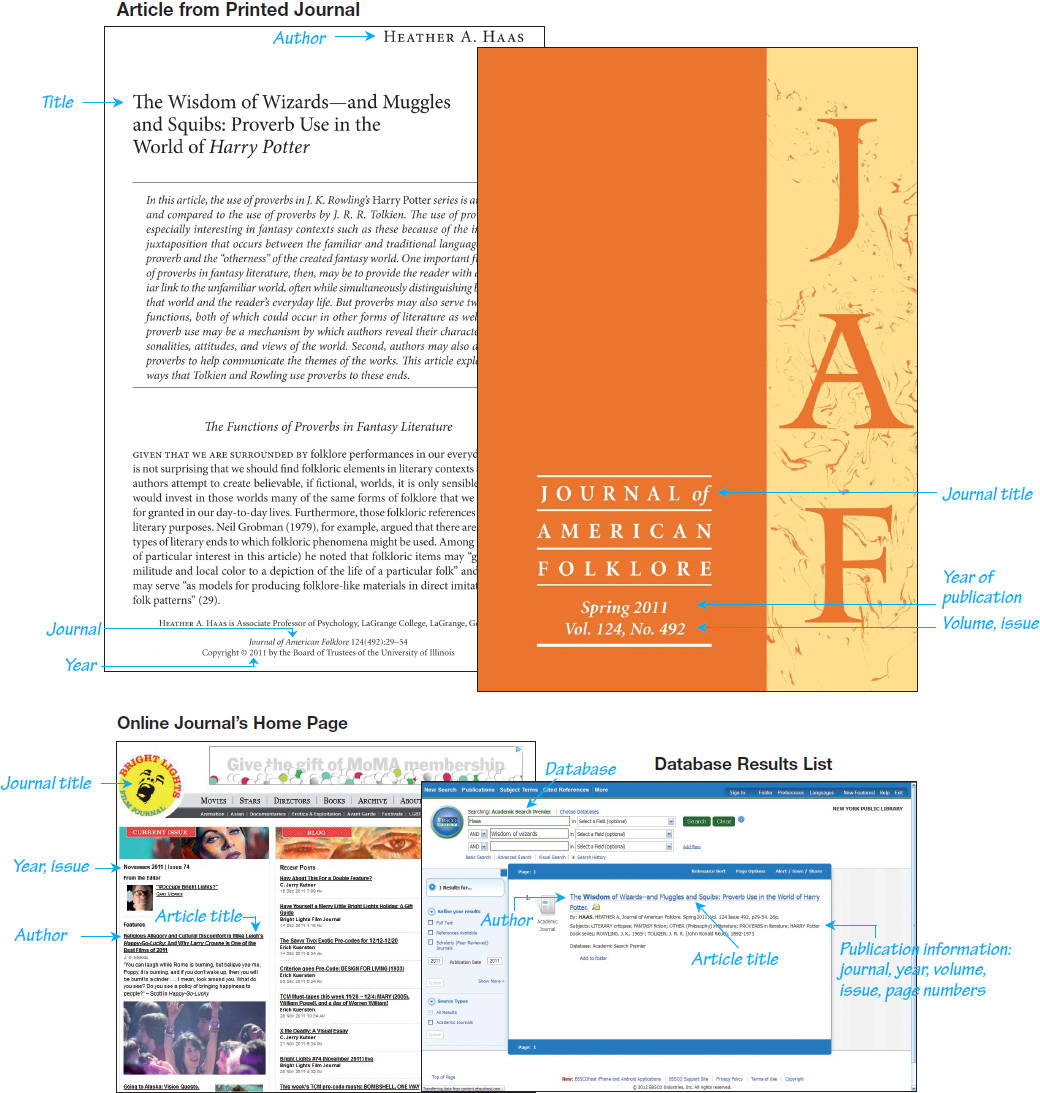
From a newspaper (print, online, database) Newspapers are identified by date, not volume and issue numbers, with the names of months longer than four letters abbreviated. If the article is from a special edition of the newspaper (early ed., natl ed.), include the edition name after the date. If articles are not on a continuous series of pages, give only the first page number followed by a plus sign. For unpaginated articles accessed through a database, use n. pag.
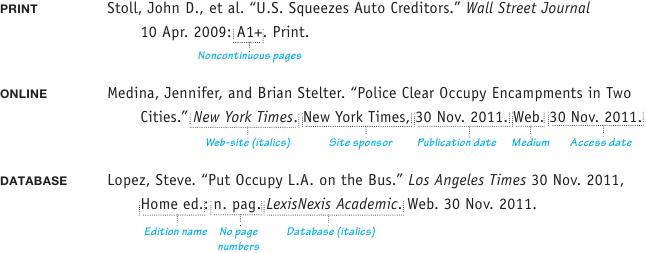
From a magazine (print, online, database) Magazines (like newspapers) are identified by date, with the names of months longer than four letters abbreviated. For magazines published weekly or biweekly, include the day, month, and year; for magazines published monthly or bimonthly, include the month and year. If the article is unsigned, alphabetize by the first important word in the title (ignoring A, An, and The).
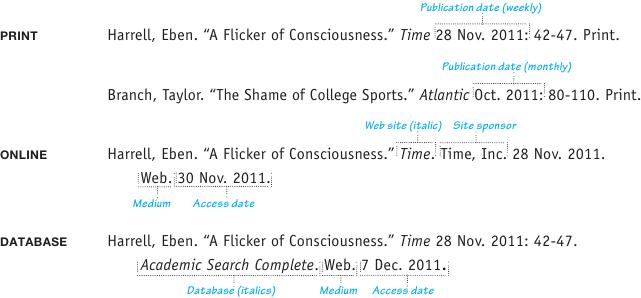
Editorial or letter to the editor
“Stay Classy.” Editorial. New Republic 1 Dec. 2011: 1. Print.
Wegeiser, Art. “How Does He Know?” Letter. Pittsburgh Post-Gazette 30 Nov. 2011: B6. Print.
Review If the review does not include an author’s name, start the entry with the title of the review. If the review is untitled, begin with Rev. of and alphabetize under the title of the work being reviewed. For a review in an online newspaper or magazine, add the site sponsor and access date and change the medium to Web. For a review accessed through a database, add the database title (in italics) and access date and change the medium to Web.
Cassidy, John. “Master of Disaster.” Rev. of Globalization and Its Discontents, by Joseph Stiglitz. New Yorker 12 July 2002: 82-86. Print.
Multimedia Sources (Live, Print, Electronic, Database)
Lecture or public address

Letter If the letter has been published, treat it like a work in an anthology (p. 717), but add the recipient, the date, and any identifying number after the author’s name. If the letter is unpublished, change the medium to MS (“manuscript”) if written by hand or TS (“typescript”) if typed.

Map or chart (print, online)
| Map of Afghanistan and Surrounding Territory. Map. Burlington: GiziMap, 2001. Print. | |
| ONLINE | “North America, 1797.” Map. Perry-Castañeda Library Map Collection. U of Texas, 21 June 2011. Web. 1 Dec. 2011. |
Cartoon or comic strip (print, online) Provide the title (if given) in quotation marks directly following the artist’s name.
| Cheney, Tom. Cartoon. New Yorker 10 Oct. 2005: 55. Print. | |
| ONLINE | Hunt, Tarol. “Goblins.” Comic strip. Goblinscomic.com. Tarol Hunt, 29 Sept. 2011. Web. 30 Nov. 2011. |
Advertisement (print, broadcast, online)
| Hospital for Special Surgery. Advertisement. New York Times 13 Apr. 2009: A7. Print. | |
| BROADCAST | Norweigian Cruise Line. Advertisement. WNET.org. PBS, 29 Apr. 2012. Television. |
| ONLINE | Volkswagen Passat. Advertisement. Slate. Slate Group, 1 Dec. 2011. Web. 1 Dec. 2011. |
Work of art (museum, print, Web site) Include the year the work was created, the medium (Oil on canvas), and the museum or collection and its location. If the work was accessed online, include the Web site name and your date of access and change the medium to Web.
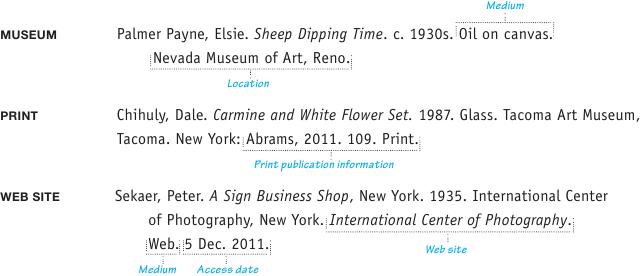
Musical composition
Beethoven, Ludwig van. Violin Concerto in D Major, Op. 61. 1809. New York: Edwin F. Kalmus, n.d. Print.
Gershwin, George. Porgy and Bess. 1935. New York: Alfred, 1999. Print.
Performance
The Agony and the Ecstasy of Steve Jobs. Writ. and perf. Mike Daisey. Dir. Jean-Michele Gregory. Public Theater, New York. 25 Nov. 2011. Performance.
Television or radio program Include the network, local station, and broadcast date. Treat a show you streamed as you would a Web page, but include information about key contributors (host or performers, for example) as you would for a broadcast television or radio program. If you downloaded the program as a podcast, include the information as for a broadcast program, but change the medium to match the type of file you accessed (MP3, JPEG file).

Podcast (streamed, downloaded) Treat a podcast you listened to or watched online as you would an online television or radio program (see “A Perfect Terrorist” entry above). Treat a podcast you downloaded as you would a television or radio program you downloaded (see “Patient Zero” entry above).
Film (theater, DVD, streamed)
| THEATER | Space Station. Prod. and dir. Toni Myers. Narr. Tom Cruise. IMAX, 2002. Film. |
| DVD | Casablanca. Dir. Michael Curtiz. Perf. Humphrey Bogart, Ingrid Bergman, and Paul Henreid. 1942. Warner Home Video, 2003. DVD. |
| STREAMED | The Social Network. Dir. David Fincher. Writ. Aaron Sorkin. Perf. Jesse Eisenberg, Justin Timberlake, and Andrew Garfield. Columbia Pictures, 2010. iTunes. Web. 1 Dec. 2010. |
Online video
Film School. “Sunny Day.” YouTube. YouTube, 12 June 2010. Web. 1 Dec. 2010.
Music recording
Beethoven, Ludwig van. Violin Concerto in D Major, Op. 61. U.S.S.R. State Orchestra. Cond. Alexander Gauk. Perf. David Oistrakh. Allegro, 1980. CD.
Maroon 5. “Moves Like Jagger.” Hands All Over. A&M/Octone Records, 2011. MP3.
Interview (print, broadcast, personal) If a personal interview takes place through e-mail, change “Personal interview” to “E-mail interview.”
| Ashrawi, Hanan. “Tanks vs. Olive Branches.” Interview by Rose Marie Berger. Sojourners Feb. 2005: 22-26. Print. | |
| BROADCAST | Dobbs, Bill. “Occupy Wall Street.” Interview by Brooke Gladstone. On the Media. Natl. Public Radio. WNYC, New York, 7 Oct. 2011. Web. 1 Dec. 2011. |
| PERSONAL | Ellis, Trey. Personal interview. 3 Sept. 2008. |
Other Electronic Sources
Online sources have proliferated in the last ten years. With that proliferation has come access to more information than ever before. But not all of that information is of equal value. Before including a source found on Google in your research project, be sure that it is appropriate for a college-level writing project, and evaluate its reliability carefully.
For help evaluating online sources, see Chapter 25.
If you are using the online version of a source for which there is no model shown here, choose the model that best matches your source, change the medium as appropriate, add the date you last accessed the source, and add any other information that readers will need to find the source themselves.
Web page or other document on a Web site

Figure 27.3 shows where to find the source information you will need to create a works-cited entry for the Web page cited here.
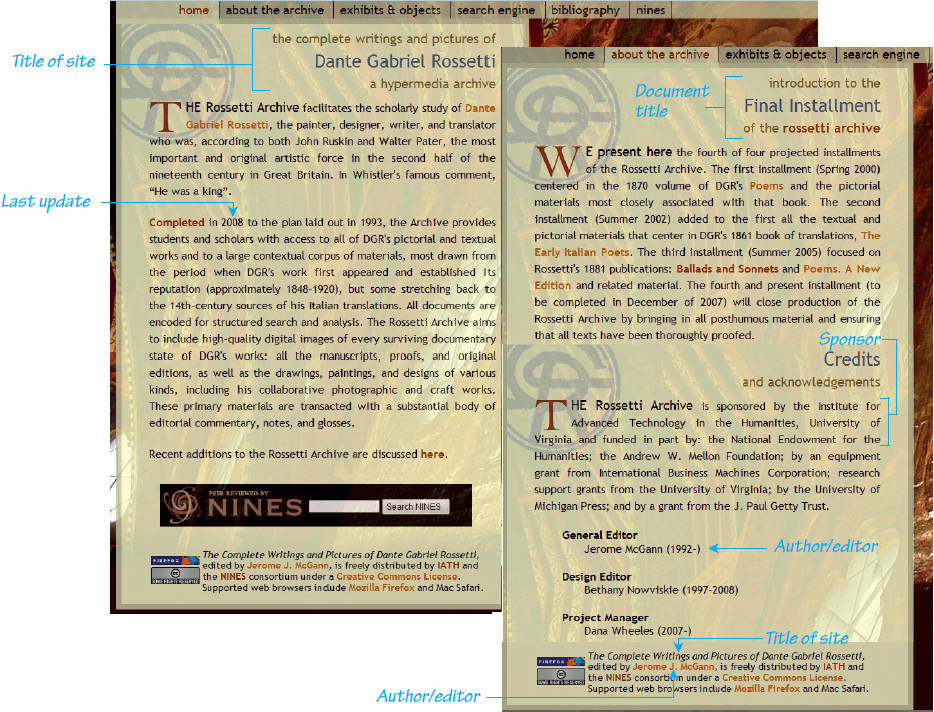
Entire Web site If the author’s name is not given, begin the citation with the title. For an untitled personal site, put a description such as Home page where the Web site’s title would normally appear (but with no quotation marks or italics). If no site sponsor or publisher is named, insert N.p. (for No publisher).
Gardner, James Alan. A Seminar on Writing Prose. N.p., 2001. Web. 1 Dec. 2011.
The Complete Writings and Pictures of Dante Gabriel Rossetti: A Hypermedia Archive. Ed. Jerome J. McGann. Institute for Advanced Technology in the Humanities, University of Virginia, 2008. Web. 16 Oct. 2012.
Chesson, Frederick W. Home page. N.p., 1 Apr. 2003. Web. 26 Apr. 2008.
Online scholarly project Treat an online scholarly project as you would a Web site, but include the name of the editor, if given.
The Darwin Correspondence Project. Ed. Janet Browne. American Council of Learned Societies and U Cambridge, 2011. Web. 1 Dec. 2011.
Book or a short work in an online scholarly project Treat a book or a short work in an online scholarly project as you would a Web page or another document on a Web site, but set the title in italics if the work is a book and in quotation marks if it is an article, essay, poem, or other short work, and include the print publication information (if any) following the title.
Heims, Marjorie. “The Strange Case of Sarah Jones.” The Free Expression Policy Project. FEPP, 2 Nov. 2011. Web. 1 Dec. 2011.

Blog (entire blog, blog post) If the author of the blog post uses a pseudonym, begin with the pseudonym and put the blogger’s real name in brackets. Cite an entire blog as you would an entire Web site (see p. 728).

Wiki article Since wikis are written and edited collectively, start your entry with the title of the article you are citing. But check with your instructor before using information from a wiki in your research project; because content is written and edited collectively, it is difficult to assess its reliability and impossible to determine the expertise of the contributers.
“John Lydon.” Wikipedia. Wikipedia Foundation, 14 Nov. 2011. Web. 1 Dec. 2011.
Discussion group or newsgroup posting Use the subject line of the posting (in quotation marks) as the title, and include the name of the discussion or newsgroup.

E-mail message

Nonperiodical publication on a CD-ROM
Picasso: The Man, His Works, the Legend. Danbury: Grolier Interactive, 1996. CD-ROM.
Computer software
How Computers Work. Indianapolis: Que, 1998. CD-ROM.